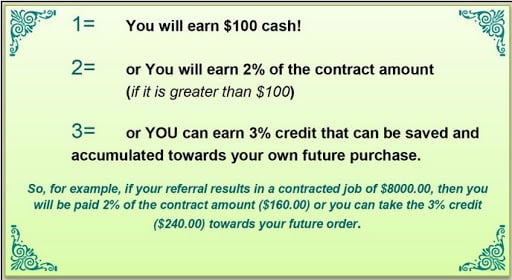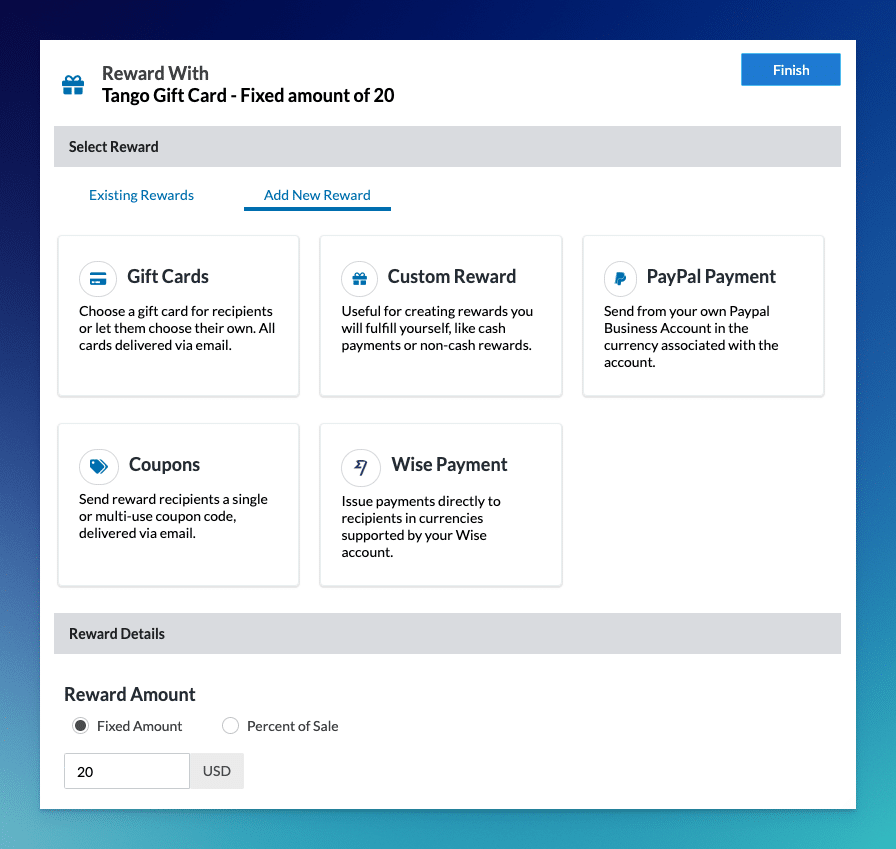What’s one of the most effective ways to consistently acquire new customers? Leveraging word of mouth – in other words, creating a consistent network of people who will refer others to your business. A finder’s fee (or commission) can help establish this referral network.
What is a finder’s fee?
A finder’s fee is a cash commission paid to someone who brings your business a new qualified lead or sale. It’s often called a referral fee, affiliate commission, or referral commission.
The fee rewards the “finder” for bringing the interested parties together and facilitating the deal. After all, it is assumed the business transaction would have never happened without this third party, so it’s only right to give them a reward. A finder’s fee can come in two forms: a flat fee, and a percentage commission.
Sometimes, finder’s fees are also used in employee referral programs, to incentivize people for bringing in new employees. But this article focuses on the fees paid in return for leads and sales.
Free Download: Calculate the best finder’s fee with our free referral fee calculator!
Who could receive a finder’s fee?
Finder’s fees could be paid out to customers, partners, or ambassadors – essentially, any third party who brings you new leads or sales. These aren’t just any third parties, though. They believe in your business, and have friends, clients, or an audience who they know would appreciate your products or services. And when offered the chance to get financial incentives for their sharing, they’re more than eager to bring you new leads and new business.
Who pays a finder’s fee?
The business who created the finder’s fee agreement pays the fee. If you’re offering such a fee, be prepared to pay it every time someone meets your conditions.
With that said, fee costs are sometimes factored into a product or service’s purchase. In this case, it would be the buyer that technically pays the fee.
There’s also third-party software you can use to help track and automate fee payouts, including referral software if you choose to pay finder’s fees through a referral program.
Is a finder’s fee the same as a referral fee?
The terms “finder’s fee” and “referral fee” are generally interchangeable. Both refer to giving a reward when a third party brings you new leads and sales.
Most commonly, though, people use the term “finder’s fee” for more formal circumstances, such as when you pay:
✅ Licensed professionals who send you a deal
✅ Partners or affiliates (bound by a formal agreement) who make the referrals
✅People with expertise in your niche or industry who bring you leads or sales
✅ Agents or brokers, who are actively looking to connect potential buyers and sellers to close a deal
How to know if you’re ready for a finder’s fee?
Before offering a finder’s fee, the best way to ensure it will work well is by offering quality products and services. It’s also a good idea to ensure there’s lots of buzz around your company, especially in the form of positive reviews and online comments.
You want to know that customers truly believe in your business before asking them to help spread the word. Offering a referral fee won’t work if people aren’t excited about your products and services. But if you’ve already got positive buzz around your product, it’s a great time to incentivize more word of mouth.
What is the standard finder’s fee percentage?
Finder’s fee percentages vary greatly by industry and even by company. While typical referral fees generally range from 5%-35% of the transaction value, that’s a wide range, and some companies offer even more due to a competitive market. For instance, SaaS referral fees can sometimes be as high as 40-50%. We’ll cover how to determine the best finder’s fee percentage for your industry later in the article.
Or, easily figure out the best finder’s fee with our free referral fee calculator!
Why use a finder’s fee?
Finder’s fees offer many benefits:
🏆A finder’s fee encourages third parties to go above and beyond to spread the message about a business, and then rewards them for a job well done.
🕒 These fees save you time by getting others to track down new prospects, and utilizing their expertise and the relationships they’ve already built.
🤝When offered to customers, fee-based incentive programs foster a sense of community, and keep clients excited about your business.
📣Many finders already have an audience that matches yours, whether that’s a few interested peers or a legion of followers.
🧑🏿🤝🧑🏼Referred parties trust the person making the recommendation, making them more likely to make a purchase or become a qualified lead. Whether that trust comes from the finder’s authority, knowledge of your products or services, relationship with the lead, or all of the above, referrals are a reliable way to grow youur client base.
💰With finder’s fees, you have nothing to lose. You only pay the fee if the finder actually generates new clients or leads. That’s far from the risky investment of an expensive ad that could go unnoticed for the duration of the campaign.
💵It usually costs much less to pay out a finder’s fee than it does to run ads or promote another traditional marketing campaign.
📈Finally, finder’s fees are easily trackable, especially when you use a software to award and track them for you. You know how often you pay the fees and how much you’re paying out, so it’s easy to measure the results of this strategy. And if you need to, you can always adjust your fee for better results.
How does a finder’s fee work?
When your finders hunt down new business, you’ll have new connections you may have not had access to previously. Once your business confirms that a finder has brought in a qualified lead or verified sale, you reward the person who brought you this lead or customer with the fee you’ve promised.
Here is an example of how a finder’s fee might work:
1️⃣ XYZ Software promises $100 in cash to anyone who refers a new customer
2️⃣ Adam knows his friend’s business could benefit from XYZ, so he encourages her business to schedule a demo
3️⃣ Adam’s friend is sold on the software, and eventually purchases the software for her business
4️⃣ The purchase is traced back to Adam, so he receives the $100 finder’s fee from XYZ
5️⃣ If Adam successfully refers another customer, he stands to earn another $100
To make this process easier, most companies use some type of tracking software to confirm sales or qualified leads, and who exactly directed a lead or customer to your company’s website.
One example of how a finder’s fee structure might work, from Architectural Window Products.
How do finder’s fees work in referral and affiliate programs?
Within a referral program or affiliate program, you can give advocates (existing customers, affiliate, brand ambassadors, or partners) a finder’s fee as an incentive when they bring in a qualified lead or new customer. You could pay out a traditional cash finder’s fee, or you could award the fee as store credits or as a gift card.
Finder’s fees encourage advocates to keep reliably sending new customers your way. And the program covers the cost of the fee, because you only pay when the program returns results (brings in qualified leads or clients).
Based on our own data, flat fees are much more common across referral programs than percentage commissions are. 92% of Referral Rock programs reward a fixed amount, and only 8% reward a percentage of a sale. Percentage-based rewards are more common for affiliate commissions and less common for customer referral programs.
Note: We also recommend giving a reward to referred parties, to encourage them to make a purchase. While this is an important part of a referral incentive, it isn’t a “finder’s fee.” This reward is still paid for by the referral program, though, as it’s only paid out when the referred person becomes a lead or makes a purchase.
Using Referral Rock for referral program finder’s fees
Looking for a way to automate finder’s fees for your referral program or affiliate program?
Referral Rock referral software lets you adjust your finder’s fee amount and type of payout as needed, for maximum flexibility. Plus, offer cash fees alongside other reward types if you choose.
Use our Reward Builder to set up the commissions of your choice. Select the type and amount of the fee you’d like to offer, and choose whether you’d like to offer a flat fee or a percentage of a sale.
Choose from a variety of referral fee payouts, as well as other rewards:
- PayPal cash payments
- Wise cash payments
- Custom cash payments
- Gift cards
- Coupons
- Other custom rewards
Determining your finder’s fee: 4 key factors
Here are four factors to remember while working on this part of your finder’s fee plan:
1. How much you spend to acquire a sale
Determining how much you already spend on a customer is crucial, as that will give you a benchmark on how much you should spend for your finder’s fee.
First, determine what a new customer is worth to you. Then, decide on the amount that makes sense to spend for your business to acquire each customer.
Consider these points of data, if you have them:
- Customer Lifetime Value (LTV)
- Average Purchase Price
- Return on Ad Spend (ROAS)
- Customer Acquistion Costs (CAC)
- Payback Period (how long it takes for your business to recover the CAC)
- Gross Profit Margin
Use all this data to create a range of what you’re willing to spend on a finder’s fee. Set your minimum and maximum amounts.
Remember that a finder’s fee should reflect the value of a sale, to motivate people to keep sending referrals your way. But it should also make sense for your bottom line.
If there is a substantial cost of doing business for the sale, you should set a lower referral fee percentage, or choose a reasonable flat fee.
2. Length of the sales process
Some sales processes take a long time to close. How long after a referral does a sale give credit to the referring party?
For relatively long cycles, will a customer be able to earn a finder’s fee at any time after their referral decides to purchase, even if it’s several months later? These conditions must be fair to both the referrer and your brand.
For longer sales processes, consider multi-step fees: a smaller fee when a lead is qualified (say, they request a demo or sign up for a trial), and then a larger payment when that referral is approved (say, they make their first purchase).
Multi-step fees motivate members to send in referrals even if it takes a while for their referral to convert to a customer. Essentially, this means “splitting up” the finder’s fee and paying part of it earlier.
Businesses that can especially benefit from multi-step referral fees include sales-led B2B and SaaS companies, staffing agencies, and higher-value services that require a more “consultative” approach (i.e. HVAC installation, landscaping, plumbing, construction contracting).
3. When and how you get paid
You should only pay out a finder’s fee when you see results: when your business makes a sale (or in some cases, when a lead is qualified).
To help determine the conditions of your fee, think about the answers to these payment questions:
- When and how does your business get paid?
- How are funds received for the sale? Upfront or in several installments?
- Do you offer a recurring service?
- What’s your policy for refunds or money-back guarantees?
When cash is received helps you plan out your payment schedule. No matter what you decide, ensure you are receiving a return on investment before you pay out the finder’s fee.
4. The payment structure you want to use
Depending on your sales process and how you want to motivate finders, you might look beyond the typical structure where every referral earns the same fee for a finder.
- You might use a tiered structure, where you pay higher fees (or higher fee percentages) as advocates bring in more referrals.
- And if your sales process is longer, you might use a multi-step structure, where you offer a smaller fee for bringing in qualified leads and a larger fee for bringing in sales.
- In addition, you might offer different fees for different types of finders. Usually, you’ll want to pay higher fees to experts and for formal partnerships, compared to fees for informal referrals from customers.
- Sometimes, subscription or service businesses offer a recurring finder’s fee, where the finder gets paid again if their referral renews their subscription or contract.
Tax and legal considerations
Highly regulated industries often have state or federal laws, or industry license rules, that do not permit finder’s fees. Legal professionals, real estate agents, financial services, and automotive sellers must be the most careful. Check with your own region and/or organization to be sure that a finder’s fee is legal for your location and industry.
You should also be aware of the tax implications of these fees. In the United States, if someone earns finder’s fees totaling $600 or more in a calendar year, they must pay taxes on them.
As a business paying out these types of fees, you are responsible for collecting a W-9 form from, and issuing a 1099 to, anyone you pay more than $600 in a calendar year.
Something else to consider, though, is that if a previous customer refers others to your business (like in a refer a friend program or with a referral software) the amount you pay to the referrer can be considered a refund or discount. This is similar to the process behind manufacturer’s mail-in rebates.
Free Download: It’s easy to determine the best finder’s fee with our referral fee calculator!
What is a finder’s fee agreement?
A finder’s fee agreement (or referral fee agreement) is a formal agreement binding the finder and the business owner, and in which the finder’s fee details and conditions are outlined.
It’s up to you whether you want to outline a formal agreement. You won’t need it for customer referral programs, but you should definitely create one if you’re recruiting affiliates or creating a more formal referral partnership.
Most agreement templates include the following sections:
- Role of the finder
- What is considered an accepted referral
- Most are tied to a sale
- But you can also award finder’s fees for qualified leads if your sales process is longer
- Compensation
- Amount or percentage you’ll pay
- There are many ways to calculate the fee; see our other sections above
- Fee schedules
- When and how you’ll pay
- Don’t forget to consider return and refund policies
Remember that finder’s fees involve your money, and there are things that can go wrong. It is worth the time upfront to come up with an agreement to protect your business from fishy or unethical activity, especially since the costs involved can be high.
Finder’s fee examples
How do companies utilize finder’s fees in a fair manner – one that benefits the finder, but doesn’t make things too expensive for you or the customer?
Here are some of the most common examples, by industry.
1. Auto sales
With auto sales, you have a large purchase price and a lower frequency of sales. You also often have a salesperson involved at the dealership. Margins are typically thin, and often even compensated by the manufacturer.
Still, asking customers for referrals, or securing partners in locations like a car repair shop or body shop, is a great way to find potential customers. Most finder’s fees for automotive sales are bound to a sale, and are a flat fee in the amount of $100-$300.
2. Software businesses
In the world of software sales, you’ll often hear about ACV or annual contract value. This is the value assigned to the average revenue of each of your company’s customer contracts, minus one-time fees.
Jason Lemkin outlines a strong example of how finder’s fees could work for your software business. His example utilizes multiple percentages, depending on how much work the referrer puts in for your business:
- “35–40% of first-year ACV if they bring you a closed, signed lead. It would cost you that much to acquire and close that lead yourself.
- 15–20% of first-year ACV if they bring you a true opportunity. i.e., if they do the marketing part, but not the sales part.
- 10% or so for a lead. Much more than this, without deep qualification of the lead, gets expensive.”
3. Project-based services
If a project is worth $50,000 in revenue, a reasonable amount to pay should be 5-10% of the first project. If finder’s fee percentages are too high, the customer will find somebody cheaper.
4. Consultant services
Flat fees with a combination of percentage-based fees are often done with consultants and services. There isn’t a typical finder’s fee for consultants as it varies strongly.
Use a finder’s fee to get more referrals
A finder’s fee won’t work if people aren’t excited about the products and services you offer. A traditional finder’s fee incentivizes someone to share information with their network. But why would they share this information if they didn’t believe in it?
Once you’ve determined that your products or services are referrable, it’s time to create the referral engine by offering an incentive for sharing. You’ll need to give adequate compensation to those who are willing to find customers on your behalf.
If you’re expecting to pay out lots of finder’s fees in a referral or affiliate program, our referral software can automate the process. Schedule a demo to see what Referral Rock can do for you >







